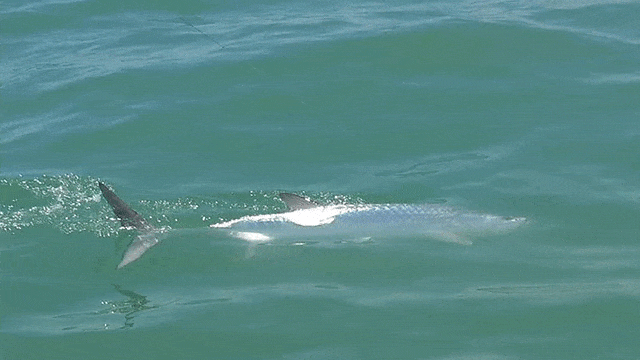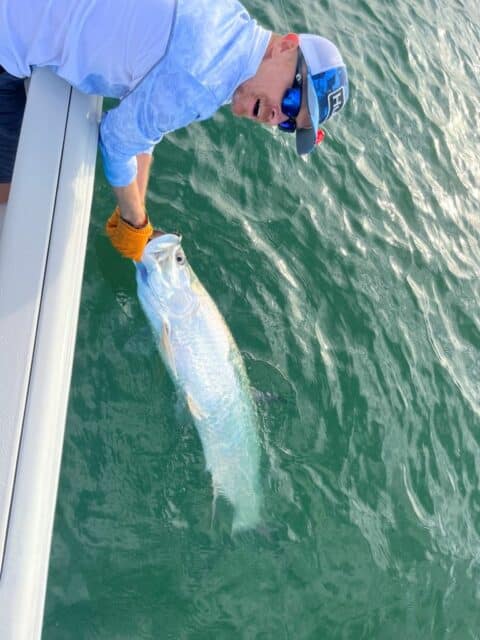Tarpon are one of the most sought after, prized fish that anglers target. Another common name for the tarpon is the silver king. These amazing, prehistoric looking fish can grow to weights over 250 pounds and measure more than 6 feet long. They are one of the most acrobatic fish anglers can target and often leap wildly out of the water when hooked. They are super strong and can put even the heaviest tackle to the test.
Tarpon can be found in much of the water in the western Atlantic. They live reside along coast from Virginia to the Florida Keys, all along the gulf coast and all the way down to central Brazil. They are awesome animals and one of the most difficult and exciting to target. Today, well cover some of the best techniques to catch tarpon.
Where to Target Tarpon
Tarpon all always on the move. They travel in large schools and hunt their prey. Some of the best places to fish for tarpon include,
- Beaches
- Inlets/passes
- Channels
- Bridges
- Bays
- Backwaters
- Rivers mouths
- Residential ponds/canals
Each year, as the water begins to warm, tarpon start to migrate toward the coastline. Along the way, they stage in inlets, passes, brides and channels to rest up during their transit and prepare for spawning.

When tarpon school up on the beach, they generally swim parallel to the shoreline anywhere from a few hundred yards to a few miles off the beach. This is where the majority of the really big, breeder tarpon are caught. Most of the smaller juvenile tarpon can be found in the residential ponds and canals and other inshore backwaters.
Look for rolling tarpon
Tarpon have the unique ability to breathe air, and they frequently breach the surface to gulp air, giving away their location. When tarpon do this, it is often referred to as “rolling.” This makes them relatively easy to spot and anglers get a bait in front of. Anglers who see tarpon rolling in the distance can get an idea of what direction the fish is headed. However, enticing a tarpon to strike is a whole different challenge.
Tarpon are extremely smart fish and won’t bite just any bait or lure. This makes them one of the most difficult fish to catch on a consistent basis. Conditions have to be good, the fish have to be in just the right mood and everything must go as planned for anglers to land a big tarpon.
When to Target Tarpon
Tarpon can be caught year-round, however, the peak season for targeting tarpon is anywhere from April to August.

Although tarpon can be caught anytime, cloudy or rainy days are some of my favorite times to target them. Clouds and wind help break up the surface clarity and therefore make it harder for tarpon to see anglers and know they are nearby. The more stealthy anglers can be when targeting tarpon, the better.
Best Baits/Lures for Tarpon
A lot of tarpon anglers use live bait when targeting the silver king. Live bait is the best technique to maximize your chances of hooking a tarpon. Baits that tarpon naturally feed on, such as pilchards, threadfins, crabs, mullet, ladyfish, and large shrimp all great options. Its best to rig live baits on a 5/0-8/0 heavy duty circle hook.
Depending on conditions and location, anglers should rig their live bait a few different ways. If on fishing an area with not a lot of current, either freelining the bait or rigging it under a cork is est. But if fishing in an inlet or channel where the current is strong, rigging the bait on the bottom with a sinker might be a better option.
For anglers wanting to target tarpon on artificial lures, some of the best include, swimbaits, artificial shrimp, and other soft-plastic lures. I really like a swimbait because it imitates baitfish well. Purple, white, black, gold, and chartreuse are some of my preferred colors for artificial lures when tarpon fishing.
Best Tackle for Tarpon
When fishing for tarpon, anglers should use hefty tackle. Tarpon are very strong fish and required the proper tackle if anglers want to successfully land them. When fishing for really big tarpon, on the beach for instance, I prefer a 6000-8000 sized spinning reel, spooled with 40-pound braided line.
I pair that reel with a 7’-8’ heavy spinning rod. I want a rod that long enough to allow me to cast a good distance, but also have plenty of backbone to handle a 200-pound fish. I use 50–100-pound fluorocarbon leader depending on the situation and size of the fish I’m around.
If I’m targeting smaller tarpon, in a backwater pond or residential canal, I go with a little lighter setup. I prefer a 5000 sized reel, spooled with 30-pound braided line and paired to a 7’ medium heavy rod. This setup will work fine when fishing for juvenile tarpon and allow me to cast farther and more accurately.
Additional Tips
1. Sharpen Your Hooks
When anglers target tarpon, they should always be sure to check their hooks and sharpen them frequently. Even if hooks seem sharp right out of the pack, it doesn’t hurt to sharpen them some more before use. Tarpon have extremely rough mouths and jaws. It can be very difficult for even the sharpest hook to penetrate deep enough to keep one of these powerful fish hooked long enough to land it.
2. Bow to the Fish
Tarpon anglers often use the term “bowing to the fish.” All this means is that when the tarpon jumps out of the water and shakes its head, anglers should point the tip of their rod directly toward the fish. This takes away some of the tension between the angler and the fish. It lessens the chances of the fish breaking the line or straightening the hook.
3. Put Enough Line on Your Reel
When tarpon fishing, anglers must be sure to spool their reels with enough line. Tarpon are super strong and can make runs up to hundreds of yards long. Therefore, its important to have a full reel that can hold a lot of line. That way, anglers decrease their chances of getting spooled by a giant tarpon and losing not only the fish, but all of their line as well.
Back to You
Tarpon are vicious, amazing creatures and are one of the most fun fish to target. They aren’t the easier to catch, but that’s what makes them so fun to fish for. If you ever find yourself tarpon fishing, be sure to use some of these tips and techniques. Hopefully they will help you get more bites and maybe even land yourself a silver king!
